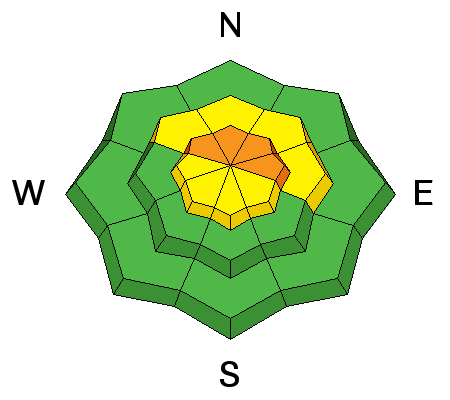25th Annual Black Diamond Fall Fundraising Party
Thursday, September 13; 6:00-10:00 PM; Black Diamond Parking Lot

25th Annual Black Diamond Fall Fundraising Party
Thursday, September 13; 6:00-10:00 PM; Black Diamond Parking Lot
| Advisory: Ogden Area Mountains | Issued by Evelyn Lees for Monday - January 15, 2018 - 7:14am |
|---|
 |
special announcement To get help in an emergency (to request a rescue) in the Wasatch, call 911. Be prepared to give your GPS coordinates. If you trigger an avalanche in the backcountry, but no one is hurt and you do not need assistance, please notify the nearest ski area dispatch to avoid a needless response by rescue teams. Thanks.
|
 |
current conditions It's another beautiful calm, clear morning in the mountains – temperatures are in the twenties and low 30s. The northerly winds are very light, less than 10 mph, with the highest peaks only averaging 15 mph, and gusting to 20 - almost unheard of for the Ogden ridge line. If you are searching for powder, head to wind sheltered, low angle shady slopes above about 8,000'. Unfortunately, the low to mid elevations are still plauged by low snow, making access and exits tedious. All the sunny slopes will be crusted this morning, damp and sloppy later in the day. Spoiler alert: warm temperatures combined with possible high, thin clouds may cause “greenhousing”, heating the snow on the northerly facing slopes today. |
 |
recent activity There were no reports of avalanches from the backcountry yesterday or at the Ogden resorts, though no explosive work was done. Slides continue to be triggered by people and explosives in the Salt Lake and Park City area mountains, and collapses are being reported from mid and upper elevations. Improved visibility allowed observers to note the signicant avalanche cycle along the Ben Lomond to Willard Peak headwall from earlier in the week. Hardesty/Brandt photos. Observations here and here.
|
| type | aspect/elevation | characteristics |
|---|


|


|

LIKELIHOOD
 LIKELY
UNLIKELY
SIZE
 LARGE
SMALL
TREND
 INCREASING DANGER
SAME
DECREASING DANGER
|
|
description
“Poor structure” and a “persistent weak layer” are the buzzwords of the Wasatch snowpack. Translated – “strong snow sitting on weak snow” and “facets”. Collapsing and avalanches are indications a person can still trigger an avalanche. The poor snowpack structure exists above about 8300' in the Ogden area mountains and is most pronounced on the northerly through easterly aspects. Cracking, collapsing, snow tests and recent explosive control work offer testimony to areas of unstable snow. Careful snowpack evaluation and cautious route-finding is required. |
 |
weather The high pressure ridge will weaken just a bit today, allowing for periods of high thin clouds. Temperatures will warm into the upper 30s to mid 40s. The northeasterly winds will be in the 5 to 15 mph range, with speeds across even the highest ridgelines only in the 20 to 25 mph range. A few snow flurries are possible Tuesday night into Wednesday, with a colder, stronger storm forecast for Friday into Saturday. |
| general announcements CLICK HERE FOR MORE GENERAL INFO AND FAQ Support the UAC through your daily shopping. When you shop at Smith's, or online at REI, Backcountry.com, Patagonia, NRS, Amazon, eBay a portion of your purchase will be donated to the FUAC. See our Donate Page for more details on how you can support the UAC when you shop. Benefit the Utah Avalanche Center when you buy or sell on eBay - set the Utah Avalanche Center as a favorite non-profit in your eBay account here and click on eBay gives when you buy or sell. You can choose to have your seller fees donated to the UAC, which doesn't cost you a penny. This information does not apply to developed ski areas or highways where avalanche control is normally done. This advisory is from the U.S.D.A. Forest Service, which is solely responsible for its content. This advisory describes general avalanche conditions and local variations always occur. |